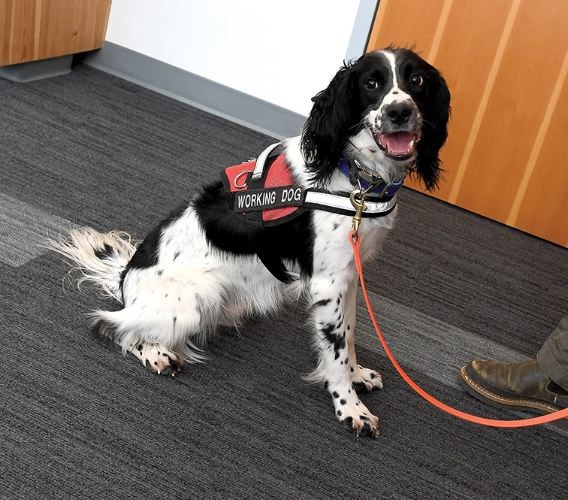A doggie disease detector was sniffing around Prince George's hospital on Wednesday.
Angus, a five-year-old English springer spaniel is one of the few dogs in North America that can seek and find one of the medical industry's most troublesome onsite conditions, the Clostridium Difficile (C.Dif) strain of bacteria.
According to American statistics, half a million people contract C.Dif each year and 94 per cent of them got it due to some kind of medical care. This bacteria hangs out in hospitals and other healthcare facilities.
"Right now there is no logistically feasible technology to do with the dogs can do," said Angus's handler Teresa Zurberg, who works mostly for Vancouver Coastal Health but travels to other jurisdictions to show what the dogs can do (Angus has a partner, Dodger, who can also do it). "Angus and Dodger are able to identify environmental contamination reservoirs very quickly and accurately."
This helps medical facilities pinpoint where to clean in the special ways necessary to kill the C.Dif presence.
"It's fairly common," said Mindy Thompson, coordinator of housekeeping and laundry services at the University Hospital of Northern BC (UHNBC). "We have cases pretty much all the time at the hospital. It is very hard to get rid of. It takes special cleaners and staff need to take twice as long to clean those spaces."
It's something Zurberg knows firsthand. She is a passionate C.Dif dog handler because she once spent a week in hospital herself after contracting it during unrelated healthcare activities.
"To this day I still have ongoing side effects," she said, pledging to work with the dogs and health officials "to have people not go through what I went through."
Angus demonstrated his nose by sniffing out a detoxified dose of C.Dif hidden in a training room at UHNBC. Some tasty treats and some exciting play with his favourite chew toy were all the incentives he needed.
"It's the same way we train a bomb dog or a drug dog," said Zurberg, explaining that the dogs are not interested in the materials they are tasked to seek. "He's learned that finding that C.Dif odor gets him what he wants. It's a game of association for the dogs."
Two more dogs like Angus and Dodger are in training in Vancouver to allow for more of these canine detection resources to help reduce this in-house issue in hospitals everywhere. Having such a concentration of them in B.C. is a close-at-hand option for UHNBC and other facilities within Northern Health.
"We heard about it and we are going to use it as a learning opportunity, find some better ways to improve our practice," said Thompson.
With the help of B.C.'s smallest healthcare professional, more contractions of C.Dif can be nipped in the bud. It's a problem Angus and Dodger hope to have licked.



